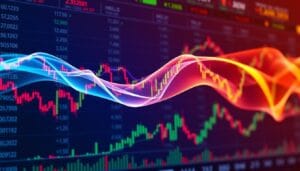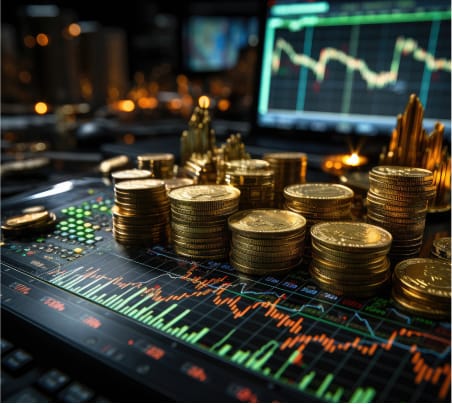The foreign exchange (Forex or FX) market is massive and fast-moving. It sees over $6.6 trillion traded daily. This makes it the world’s largest financial market.
Forex trading requires understanding key concepts and fundamentals. These are crucial for success in this dynamic market. Let’s explore the essentials every trader needs to know.
Key Takeaways
- The Forex market is the world’s largest and most liquid financial market, with a daily trading volume of over $6.6 trillion.
- Understanding the key participants, major currency pairs, and trading sessions is crucial for Forex traders.
- Both fundamental and technical analysis are essential tools for Forex market analysis.
- Risk management is a critical component of successful Forex trading, including the use of leverage.
- Forex traders can employ a variety of strategies, such as day trading and swing trading, to capitalize on market opportunities.
Understanding the Forex Market
The forex market is a global currency trading platform. It’s open 24/5 and is the world’s most liquid financial market. Traders, banks, and institutions all play key roles in this dynamic marketplace.
What is the Forex Market?
The forex market is where currencies are bought and sold worldwide. It’s the largest financial market, with daily trades exceeding $6 trillion.
Currencies trade in pairs, like USD/EUR. Their exchange rates change based on economic and political factors.
Key Participants in the Forex Market
The forex market has several important players:
- Banks – Large banks provide liquidity and set exchange rates.
- Institutional Investors – Hedge funds and mutual funds trade to manage risk and earn returns.
- Retail Traders – Individuals use online platforms to trade currencies.
- Central Banks – They intervene to influence rates and maintain monetary policies.
The forex market structure is decentralized, with no single physical location. It operates through electronic platforms, allowing round-the-clock trading five days a week.
“The forex market is the most liquid financial market in the world, with a daily trading volume of over $6 trillion. It’s a dynamic and complex ecosystem, where various participants interact to exchange one currency for another.”
Major Currency Pairs
The Forex market is the world’s largest financial market. Currencies are traded in pairs here. Major currency pairs are the backbone of the Forex market.
These pairs have high liquidity and tight spreads. They make up a large portion of global Forex trading volume.
The three most prominent major forex currency pairs are:
- EUR/USD (Euro/US Dollar)
- USD/JPY (US Dollar/Japanese Yen)
- GBP/USD (British Pound/US Dollar)
These forex currency pairs are widely traded for several reasons. They’re easy to access and have high volatility. The economies behind them are also important.
Traders use these pairs to gauge overall Forex market health. Their changes can affect other currency pairs’ performance.
| Currency Pair | Nickname | Trading Volume |
|---|---|---|
| EUR/USD | The Beast | 28% of total Forex volume |
| USD/JPY | The Dragon | 17% of total Forex volume |
| GBP/USD | The Cable | 12% of total Forex volume |
Knowing how these major forex currency pairs work is vital. It helps traders succeed in the ever-changing Forex market.

“The Forex market is like a vast ocean, and the major currency pairs are the currents that shape its tides. Mastering their ebb and flow is the key to navigating the market’s complexities.”
The Forex Market Trading Sessions
Forex trading happens 24 hours a day, 5 days a week. It spans various global financial centers. Knowing market hours and volatility can help traders find good opportunities.
Overlapping Trading Sessions
Some forex trading sessions overlap, like London and New York. This overlap can increase market activity and volatility. Traders can use these busy times to find more profitable trades.
Volatility Patterns
Forex markets show clear volatility patterns throughout the day. Some times, like London’s opening or economic data releases, see higher volatility. Traders can use these patterns to spot opportunities and manage risks.
| Trading Session | Time Zone | Typical Volatility |
|---|---|---|
| Tokyo Session | GMT+9 | Moderate |
| London Session | GMT | High |
| New York Session | GMT-4 | High |
This table shows major forex trading sessions, their time zones, and typical volatility levels. Traders can use this info to plan strategies and manage risks better.

“Understanding the forex market’s trading hours and volatility patterns is crucial for successful trading. Traders who can capitalize on these dynamics are more likely to achieve consistent profitability.”
Forex Market Analysis
Forex traders use two main analysis techniques: fundamental and technical. These approaches help traders gain insights and find trading opportunities. Understanding these methods allows for more informed and strategic decisions.
Fundamental Analysis
Fundamental analysis examines economic, political, and social factors affecting currency values. It focuses on macroeconomic indicators like GDP, inflation rates, and employment data. Geopolitical events and policy decisions are also considered.
This analysis helps traders assess a currency’s intrinsic value. It allows them to make predictions about future performance based on underlying drivers.
Technical Analysis
Technical analysis studies historical price patterns and trends in the forex market. It uses various indicators, chart patterns, and market trends to identify potential trade entry and exit points.
Technical analysts look for recurring market patterns and behaviors. This provides insights into market psychology and potential currency pair movements.
Skilled forex traders often combine fundamental analysis and technical analysis. This approach gives a comprehensive view of the forex market dynamics. Using forex market analysis techniques helps develop robust trading strategies for consistent, profitable results.

“The forex market is a complex and dynamic landscape, and effective market analysis is crucial for traders to navigate it successfully.”
Risk Management in the Forex Market
Forex risk management is vital in the ever-changing currency market. Trading currencies can be risky, so smart traders use strong strategies. These methods help protect their money and handle market ups and downs.
A key forex risk control tool is the stop-loss order. It closes trades automatically when the market turns unfavorable. This limits possible losses. Spreading investments across different currency pairs also reduces overall risk.
Leverage is common in forex, but it needs careful use. Too much leverage can lead to high risk. Traders must know their risk comfort and adjust leverage wisely.
A good trading plan is crucial for forex success. Regularly check market conditions and keep learning new risk management tricks. These habits help traders thrive in the fast-paced forex world.
“Effective risk management is the cornerstone of sustainable forex trading success.”
Using a complete risk control approach helps forex traders. It boosts their confidence and cuts potential losses. This method sets them up for long-term profit in the forex market.
Forex Market Trading Strategies
The forex market offers various trading strategies for capitalizing on opportunities. Day trading and swing trading are two popular approaches. Each has its own features and potential rewards.
Day Trading Strategies
Day trading involves opening and closing positions within one trading session. Traders aim to profit from short-term price movements. They use technical analysis tools to spot entry and exit points.
Successful day traders need a sharp eye for market trends. They must also act quickly and decisively. This fast-paced strategy requires discipline and swift execution.
Swing Trading Strategies
Swing trading focuses on holding positions for longer periods. These can range from a few days to weeks. Traders try to capture larger market moves and profit from currency price swings.
Fundamental analysis plays a key role in swing trading. Traders examine economic factors and world events. They look for catalysts that might cause longer-term price changes.
Choosing between day and swing trading depends on personal factors. These include risk tolerance, time commitment, and trading style. Many successful traders use both strategies.
They adapt their approach to changing market conditions. This flexibility helps them meet their investment goals more effectively.
| Day Trading Strategies | Swing Trading Strategies |
|---|---|
|
|
“Successful forex traders often incorporate a blend of day trading and swing trading strategies, adapting their approach to the ever-changing market conditions and their individual investment goals.”
The Forex Market and Leverage
Forex leverage is a powerful tool in trading. It can boost potential gains and losses. Traders can control larger positions with less capital, creating new opportunities.
However, forex margin trading with high leverage is risky. It’s a double-edged sword that needs careful handling.
Forex leverage ranges from 1:1 to 1:500. This means traders can control up to 500 times their investment. Small market changes can lead to big gains or losses.
- Understand the Risks: Leverage can be dangerous. Traders must know the potential risks before using it. Sudden market changes can quickly wipe out accounts.
- Develop a Robust Risk Management Plan: Successful traders use effective strategies. They set stop-loss orders and limit leverage to comfortable levels.
- Start Small and Gradually Increase: New traders should begin with lower leverage ratios. They can increase as they gain experience and confidence.
Understanding forex leverage helps traders use it wisely. They can boost potential while reducing risks. A smart, disciplined approach is key to success in forex trading.
“Leverage is a powerful tool, but it must be used with care and caution. Responsible traders understand the risks and manage them accordingly.”
Conclusion
The Forex market is vast and complex. Understanding key concepts helps traders navigate this dynamic market. Essential principles include currency pairs, trading sessions, market analysis, risk management, and leverage.
Grasping forex market conclusion leads to a deeper understanding of key forex market concepts. These forex trading fundamentals empower traders to make smart choices. They can manage risks better and aim for long-term success.
Traders can use these insights to boost their Forex performance. By refining their skills, they’ll be better equipped to reach their financial goals. Continuous learning is key in this ever-changing market.













